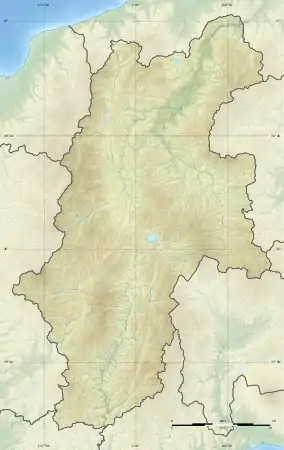Ōmuro Kofun group
Ōmuro Kofun Group (大室古墳群, Ōmuro kofun-gun) is a group of late Kofun period burial mounds located in what is now part of the city of Nagano in the Chubu region of Japan. The site was collectively designated a National Historic Site of Japan in 1997.[1]
大室古墳群 | |
 Kofun No.244 is the largest in the Ōmuro Kofun Group | |
 Ōmuro Kofun Group  Ōmuro Kofun group (Japan) | |
| Location | Nagano, Nagano, Japan |
|---|---|
| Region | Chubu region |
| Coordinates | 36°35′23″N 138°13′51″E |
| Type | kofun |
| History | |
| Periods | Kofun |
| Site notes | |
| Ownership | National Historic Site |
| Public access | Yes |
Overview
The Ōmuro Kofun Group is a large necropolis consisting of over 500 tumuli spread across two valleys in the Matsushiro neighborhood of Nagano city. The tombs were built over a 250-year period from the 5th to the 8th centuries, and have been grouped by archaeologists into five groups by their geographic location.
There is only one keyhole-shaped kofun, but at least 330 smaller dome-shaped kofun made of stacked river stones from the Chikuma River. Most of these dome-shaped kofun have a diameter of approximately 10 meters, and there is no other burial mound cluster in Japan where there are so many such dome-shaped kofun in such a small area. These mounds can be divided into 40 different variations, some with a scallop-shaped stone burial chamber, or with a triangular gabled burial chamber ceiling. Theories that these tombs were built by immigrants to Japan from the ancient Korean states of Goguryeo or Baekje remain controversial.
The 2.5 square kilometer site is now an archaeological park with a museum displaying some of the artifacts discovered.
Access
- By car, 15 minutes from the Nagano IC on the Jōshin-etsu Expressway
- By bus, 20 minutes on foot from Ōmuro Station (大室駅, Ōmuro eki) (there are sign posts from the bus stop). From JR Nagano Stationm, take the Nagaden Bus, No. 8, the Suzaka-Yashima Line, departing from the south exit of Nagano Station.
Gallery
 Burial chamber of Tomb 244
Burial chamber of Tomb 244 Tomb 168
Tomb 168 Tomb 238
Tomb 238 Tomb 240
Tomb 240 Burial chamber of Tomb 240
Burial chamber of Tomb 240 Tomb 276
Tomb 276 Ōmuro Kofun Museum
Ōmuro Kofun Museum
References
- "大室古墳群" (in Japanese). Agency for Cultural Affairs.
External links
| Wikimedia Commons has media related to Omuro Kofun Group (Nagano). |
- Nagano city cultural heritage database (in Japanese)
- Matsushiro tourist information site (in Japanese)
- Nagano city home page (in Japanese)